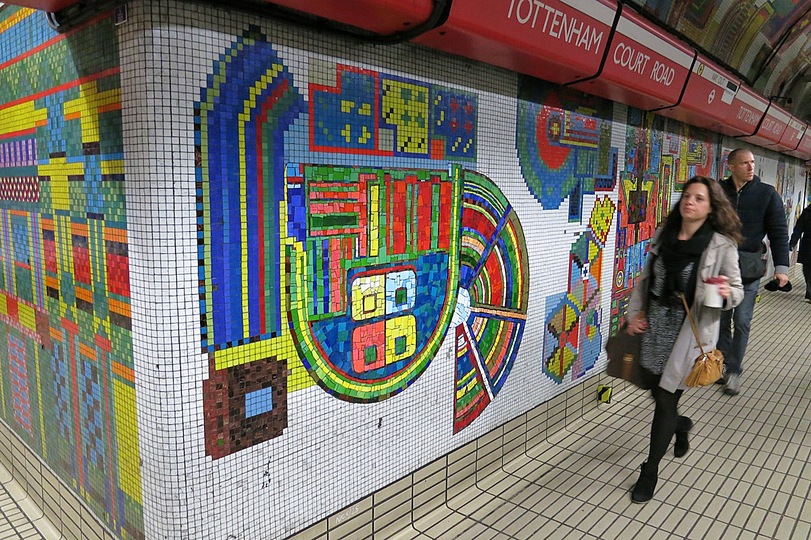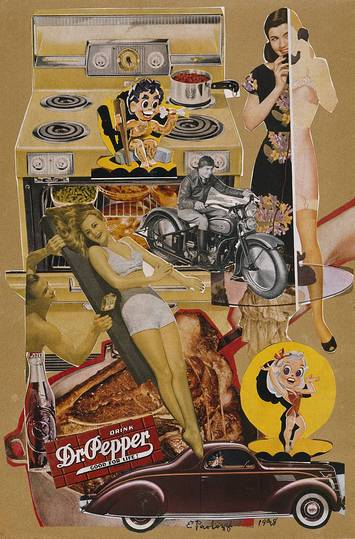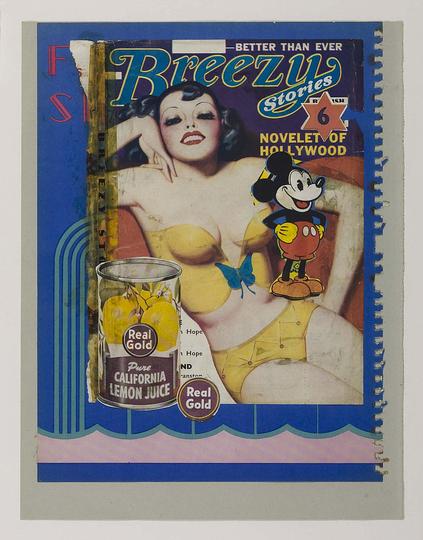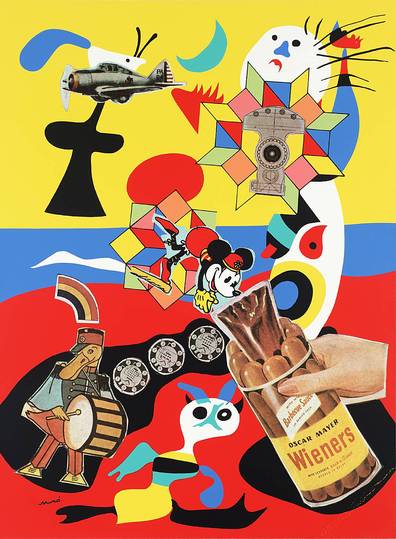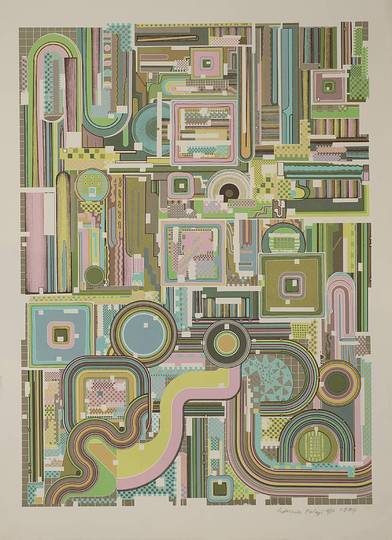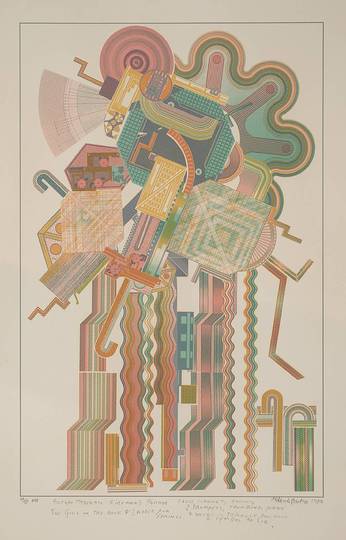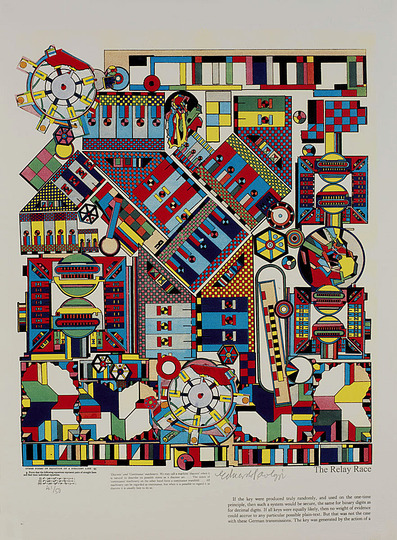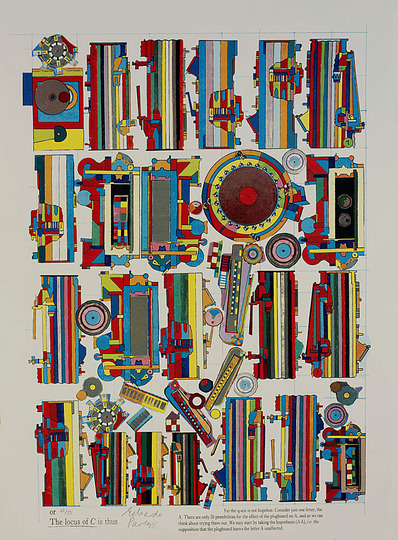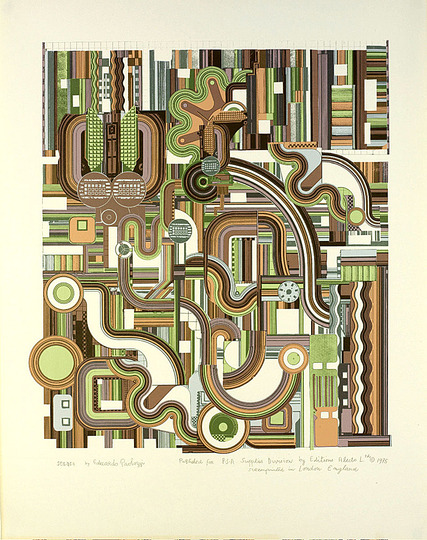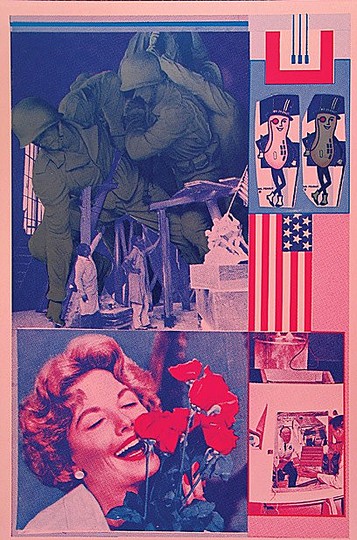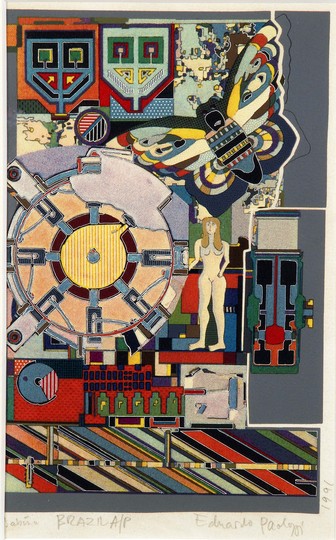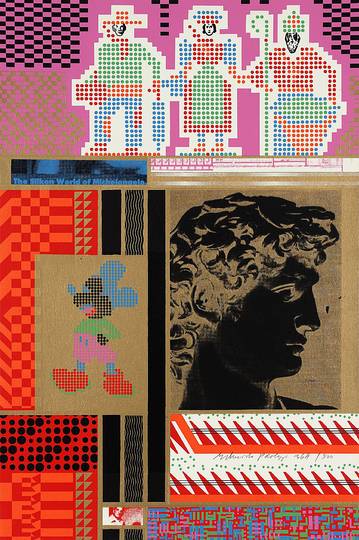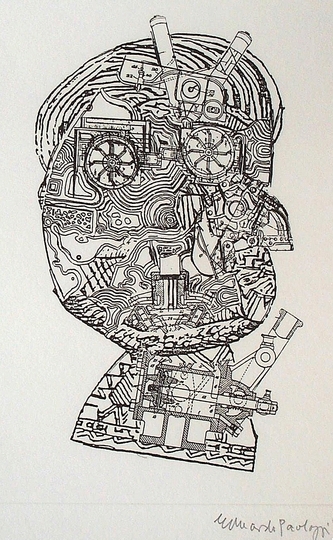Eduardo Paolozzi
Eduardo Paolozzi, the son of Italian parents, was born in Edinburgh in 1924. In 1943 he studied at the College of Art in Edinburgh in 1944 at the St Martin´s School of Art and finally at the Slade School of Art in Oxford from 1945 to 1947. There he attends to art from outside Europe, which influenced his early works. Paolozzi spent the years between 1947 and 1949 in Paris, where he got to know Arp, Brancusi, Giacometti and Léger and dealt with Surrealism as well as ´art brut´. Paolozzi was co-founder of the "Independent Group" in London in 1952/53, which discussed thoughts of including trivial culture and that way gave decisive impulses for the development of English Pop-Art. At that time Paolozzi began to be known in foreign countries, in 1952 and 1960 he participated in the Biennale in Venice, in 1959 in the documenta II in Kassel. His early sculptures of the late 1950s were totem-like archetypes of the age of technology in the form of plump robots. Paolozzi´s work changed radically in 1961 when he began using prefabricated aluminium and brass casting moulds. The demonic element was replaced by a homage to modern machines and technology. Paolozzi was not only a sculptor; he also produced graphic art and pottery, made films and was a successful writer. Paolozzi taught textile design at the Central School of Art and Design in London from 1949 to 1955 and changed to the St. Martin´s School of Art in 1955. He went to Hamburg for two years to teach at the Hochschule für Bildende Künste in 1960 and between 1977 and 1981 he held a chair at the Fachhochschule in Cologne. In 1981 he switched to the Akademie der Bildenden Künste in Munich, where he taught until his retirement in 1994. In 1989 he received the accolade. Since 1999 the main part of his work and his library as well as a reconstruction of his studio are shown at the Dean Gallery, which belongs to the Scottish National Gallery. Eduardo Paolozzi died in London in April 2005. Among Paolozzi´s best known works are his works for public places like the design of the tube station Tottenham Court Road in London with coloured mosaics, the realisation of the Rheingarten project in Cologne or the cast iron sculpture ´Piscator´ for the Euston Square in London.
Inspirations.
Art Driver
A obstacle driving computer game with visual art. Use the arrow keys on your keyboard to push obsta...
penccil: This was 2017
The penccil year in review is a project selection for 2017, this year curated by Mario Gagliardi. Se...
serpentine 2017
exhibition, schauspiel köln, cologne. steelobjects, ceramic reliefs.
BS1
temporary accessible sculpture.
We Ar
University of Sunderland MA Glass and Ceramics Show
Maurice Binder
Maurice Binder was a film title designer best known for his work on 14 James Bond films including th...
UNTITLED PROJECT: CABIN [THOREAU]
UNTITLED PROJECT: CABIN [THOREAU] [ANGLET], 2016 –– a carved and painted replica of Henry David ...
Untitled Project: Honda CB77 Superhawk
UNTITLED PROJECT: HONDA CB77 SUPER HAWK, oil paint on carved wood, 2013-2014 –– A carved/painted...
Franz Kline
Around 1950, Franz Kline radically simplified painting: “Instead of making a sign you can read, yo...
New Generation
Experiemntal art
What Is A Simulation?
What is a simulation?
It is a private game we devise when the aliveness of a situation is too comple...
The art of improvising art
The recently abandoned administrative headquarters of Austrian Post, an imposing turn of the century...
Just Before Paradise
“And just as we learn about our lives from others, so, too, do we let others shape our understandi...
Expression/Information
Painting is seen as a form of practice that—contrary to canonical accounts—in no way shies away ...
Total Automation
In The Promise of Total Automation, artists examine technology in its complexity. They point out our...
German Art since 1960
German ‘paragons of painting’ such as Georg Baselitz, Jörg Immendorff and Markus Lüpertz have ...
Jean Lurçat
Jean Lurcat, painter, poet and ceramicist, great renovator of contemporary French tapestry, produced...
Scum Pixel
'Scum' refers to a foamy layer or mass that forms on the surface of liquid when it is boiled or ferm...
The Bauhaus Revolution
The Bauhaus was the most influential design school of the 20th century.
See more in the new magazin...
In Infinity
Yayoi Kusama’s unique imagery spring from the recurring hallucinations that have haunted her since...
E=C=L=I=P=S=E
Cerith Wyn Evans is a Welsh sculptor and filmmaker. He worked as an assistant to Derek Jarman, at th...
In Orbit
"When I look at these complex layers of translucent lines and spheres, I am reminded of models of th...
Tom Ngo
"Common sense and conventional practice prohibits the evolution of architecture. Through reproducing...
Sislej Xhafa
Sislej Xhafa has furnished the waiting room of a police station in Gent like a grand palace. He pres...
Future Architecture
Future Architecture Platform is a European program which promotes talents in architecture. Future A...
Superstudio, Superproduction, Superconsumption
Superarchitecture is the architecture of superproduction, of superconsumption, of superinduction to ...
reversed silhouettes
.......
This City
This City is an audio-visual piece performed as musical alter-ego Mark Eats. It explores what happen...
Eric Giraudet de Boudemange
Eric Giraudet de Boudemange (1983) graduated in 2007 from the National School of Fine Arts in Paris ...
Christian Herdeg: Kunst und Bau
Christian Herdeg was born 1942 in Zurich. Trained as a photographer, cameraman and lighting technici...
Obsolete Distinction
In contemporary society, the digital world pervades the physical to such an extent that any distinct...
“I’m not supposed to talk about it”
Nine artists were invited to exhibit in Pyongyang, the North Korean capital of the unknown. The enti...
Francois Morellet 1926 - 2016
Since he first began making work in the 1950s, Morellet has been engaged in creating work which has ...
Xavier Antin: Printing at Home
A printer manual to disturb and disrupt the printing process.
Xavier Antin, born in 1981, lives and ...
The Oily Actor
“I had been looking around these ideas of systemic crisis, global financial crisis, which is what ...
Memories of Ruins: Rebecca Bathory
Finding beauty in darkness, poetry and meaning in the forgotten and surreal, imaginary worlds amongs...
Jewelry Design Art
Jewelry Art design pattern inspired from nonlinear dynamics.
Drawings collection about fluid flows...
BASILE ARTECO "Falce/Scythe" design anonimo
Design Anonimo, Scythe in forged iron handmade in Italy in the occasion of the exhibition of the "FE...
BASILE ARTECO "Ferro/B" design Enzo Mari
DESIGN ENZO MARI: Forged iron fruit-bowl, Limited Edition of 6 numberd and signed by the Author Enzo...
Universality of the Vortex-Sphere Archetype
The Universality of the Vortex-Sphere Archetype - Code nature sign language
Following the entire pr...
Colliding Worlds
Architectural models of small planets appear in unexpected places. (C) Mario Gagliardi 2007
Untitled Project: GOLD /eBAY
http://conradbakker.tumblr.com/post/142238609646/goldebay
Palmyra, End of March, 2016
Palmyra. City of Mesopotamia, city of the Phoenicians, of the Assyrians, the Greeks, the Persians, a...
DADAMAINO
“I have always loathed the material and have always sought the immaterial”
Dadamaino (Emilia Edo...
Alain Georges Frank Jacquet
Alain Georges Frank Jacquet was born in Neuilly-sur-Seine in 1939. After studying drama at the Unive...
Pierre Besson
Pierre Besson: Fictions begins…
Pierre Besson navigates between visual arts and architecture, and...
Tribe
Research on shapes variations to create minimalist iconic structures inspired by sports wear and typ...
Principles Of Motion
A temporary installation of phase paintings accompanied by an abstracted, shifting cinematic landsca...
Opie
Julian Opie studied at Goldsmiths´ College (1979-82) under Michael Craig-Martin, for whom he briefl...
Make War, Not Love
Digitally printed charmeuse silk series 'Touchingly Unfeeling' by Jonathan Zawada.
Jonathan Zawada...
Petrolheads
“We need to understand that we have the same problems all over the world on different levels. We a...
안 민 정 Private Pictograph
Minjeong An (1981~) studied at Seoul National University of Technology. She lives and works in Seoul...
Pareidolia
Pareidolia's narrative is based on the events surrounding the creation of Eugen Herrigel's book Zen ...
朱敬一 Standing Ink
Zhu Jingyi , born 1975 in Jiangyin, Jiangsu Province, China, studied at Nanjing Normal University a...
Wonderland
Anna Lomax is a maker and collector, working within the field of Creative Direction and Set Design f...
The 2015 best of penccil
This was an extraordinary year. The world went through a series of shocks and shake-ups, and in betw...
Pencil Factory
Pictures from the Caran D´ache pencil factory by Greg White. Born in East Yorkshire in 1978, Greg...
Spatial Objects
Spatial Objects is the result of Dan Holdsworth’s ongoing enquiry into contemporary photographic p...
Mark Fast
Mark Fast moved to London in 2002 to study at Central Saint Martins. He completed his BA there and w...
The Slave Ship
But, I think, the noblest sea that Turner has ever painted, and, if so, the noblest certainly ever p...
FLOW by Lazerian
First impressions count for everything, a principle UK creative practice LAZERIAN responded to after...
Spin it
Posters by London-based graphic design studio Spin.
Ink kisses paper
Grant Dickson, born in Belfast, 1974, studied Graphic Design at Nottingham Trent University (1994-97...
RGB Studio
RGB Studio is Rob Brearley, a graphic designer & art director based in Leeds UK. He continues to dev...
Dinu Bodiciu: Monsters
Dinu Bodiciu is a London based fashion and accessories designer. He was born in Romania and studied ...
Forward Retreat
Mark Tansey was born in California. He attended art classes at the San Francisco Art Institute and s...
Faces of the 17th century
17th century Dutch portraits from the Rijksmuseum, Amsterdam.
Absalon: Cellules
Cellules d'habitation: 6 residential modules of 9 square metres, designed to fit in 6 major cities (...
Aeronauts
Photographer Benedict Redgrove was born in Woodley near Reading, England. He studied at Berkshire Co...
Pavel Tchelitchew: Spiral head
Pavel Tchelitchew (Па́вел Фёдорович Чели́щев) (1898 - 1957) was a surrealist ...
also:
Field of Notion
Field of Notion delves into the dichotomies of light and shadows, life and death, creating a series ...
Trompe l´oeil
Rugs "Trompe l´oeil".
Design: Mario Gagliardi for Mario and Casa.
gift: 礼物
gift, color on paper, by zhu yuzhou, 2022.
Eden
Paper sculpture
Choreography of pictorial fetishes
Afterword by WM Hunt
These are photographs.
These exist uniquely as photographs. The artist, Manuel ...
McDEAD ..and lovin' it!
In Australia we call McDonalds - Maccas.
Maccas holds a special place in my heart... it's called cho...
MILEY CYRUS is a ZOMBIE
This is an unused piece for the Australian comic ZOMBIE CITIES by Zorab del Rio.
I can understand to...
TOKYO ZOMBIES
This is the inks for TOKYO ZOMBIES,
a piece I did for the Australian comic called ZOMBIE CITIES by ...
SPACE GIRL
Comic Art, Illustration, Art, Line Art, Brush, Comics.
PAISAJES DE L'EMPORDÀ
Collage
CROMOS
Collage
SALTO
Sculpture
HISTORIA DE UN HUEVO
Sculpture
EL CAMINO MÁS LARGO
Sculpture
ADELA
Sculpture
SÚBER
Sculpture
EL PAPEL DE LA FAMILIA
Ilustraciones para artículo: El Papel de la Familia (Hospital Sant Joan de Déu) 2023
VIENTO EN POPA
Mixed Technique
PINTAORA
Painting
EQUILIBRIOS
Escultura
Shop Them - DR NOKI T-shirts are here!
penccil is happy to announce its launching of penccil shop <t https://penccil.com/shop with fashion ...
Pianeti
Rug set "Pianeti", designed by Mario Gagliardi for Mario and Casa. Handcrafted in 100% New Zealand M...
curve wood
Title is affranchir la ligne, a public art commission for the lobby of a sports complex, plays with...
briller par son absence
burn wood
Surface N° 2
Arctic Paper presents Surface N° 2 – a second edition featuring a specially curated selection of ...
Coloured stones
The coloured stones is use Traditional Chinese Taihu Stone
The Demonstrations series.
A new series of paintings, oil on canvas, that deal with movement, the power and energy of the crowd...
Curtains
A series of watercolour paintings.
Architectural sculptures
Architectural sculptures by K. Kegelmann as part of "Future City" curated by Mario Gagliardi at the ...
Francesco Vezzoli: Antique not Antique
Francesco Vezzoli at MUSEO MUSEION.
Surrealism
Inspired by Surrealism and some of the artists of that time (such as Dali or Ernst), I created basic...
Arte generativo
Ejemplos de arte generativo que sirvan de inspiración
Rudolf Belling
Rudolf Belling was sculptor, designer, architect and stage designer. In 1908, he founded a studio fo...
CoBrA Magazines
The avant-garde art collective CoBrA (Copenhagen, Brussels and Amsterdam) existed from 1949 to 1951....
Alessandro Mendini 1931-2019
For Alchimia, design is a cyle: everything that will have to happen has already happened, and the im...
VAW
In late 2018, we proposed a strategic repositioning of Vienna Art Week.
We suggested a fundamental...
Pieter Bruegel
During his lifetime, Pieter Bruegel the Elder was already among the period’s most sought-after art...
Territorium: Ars - Techne-Krafts-Cosmovisión
Colección de imágenes que soportan investigación a nivel de postgrado: Maestría
Estudios Territ...
Writing & Design
Artists Abroad: A Woman´s Journey to Discover the Artists. Writer and Illustrator.
WRECK--Regeneration Experiment of Wasted Daily-use Ceramics from Chaozhou, China
WRECK, the destruction of decorum, the ruin of culture. BENTU went deep into daily-use ceramics indu...
The loft bar
Concept project of loft bar.
Stories of You
REVOIR is an interactive mirror, activated by emotion detection to create stories through visual lan...
Good design is finding a solution to a problem. Great design is finding the simplest solution to the same problem.
— Nicholas Petersen
— Nicholas Petersen
- penccil is free.
- No trackers. No cookies.
Just creativity.


